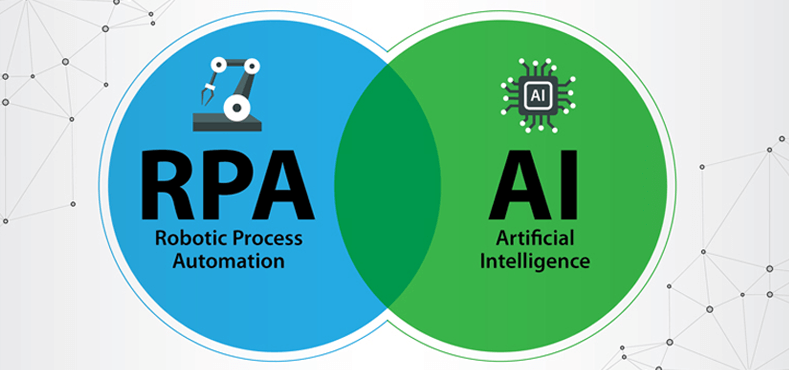Introduction
The Rise of Automation in Finance
The financial industry is undergoing a massive transformation, driven by technological innovation and the growing need for greater efficiency, accuracy, and compliance. Automation is no longer a buzzword—it’s a necessity. Financial institutions, accounting departments, and CFOs are increasingly adopting automation technologies to streamline operations, reduce manual errors, and cut costs. Among these technologies, Robotic Process Automation (RPA) and Artificial Intelligence (AI) stand out as game-changers, but they serve very different purposes.
Why Clarifying the Difference Between AI and RPA Matters
Despite their widespread use, the lines between RPA and AI are often blurred. Many decision-makers mistakenly believe these technologies are interchangeable or perform the same functions. This misconception can lead to failed automation initiatives, misplaced investments, and suboptimal results. Understanding the core differences—and how they can work together—empowers organizations to make smarter choices in their automation strategies. This article breaks down the key differences, applications, and strategic benefits of AI and RPA in financial processes.
What is Robotic Process Automation (RPA)?
Definition and Core Functionality
Robotic Process Automation (RPA) is a rule-based technology that uses software bots to mimic human actions within digital systems. It automates repetitive, structured tasks by following predefined workflows and rules. Think of RPA as a highly efficient digital assistant that can navigate software, input data, generate reports, and move files—without making mistakes or getting tired.
RPA operates at the user interface level, interacting with applications just as a human would, without altering the underlying systems. It’s especially effective in environments that rely on structured data and legacy systems.
Common Use Cases in Financial Departments
In finance, RPA is often used to automate tasks such as:
- Invoice processing and matching
- Bank statement reconciliation
- Data extraction from PDFs and spreadsheets
- Payroll processing
- Regulatory reporting
These tasks are repetitive, time-consuming, and prone to human error—making them perfect candidates for RPA.
Benefits of Using RPA in Finance
RPA offers a wide range of benefits for financial teams, including:
- Increased accuracy and reduced errors
- Faster processing times
- Cost savings through reduced manual labor
- Enhanced compliance through consistent execution
- Easy scalability without major system overhauls
By automating routine workflows, RPA frees up finance professionals to focus on higher-value activities like analysis, forecasting, and strategic planning.
What is Artificial Intelligence (AI)?
Definition and Scope
Artificial Intelligence (AI) refers to the simulation of human intelligence by machines. Unlike RPA, which follows rules, AI learns from data and makes decisions based on patterns, predictions, and context. AI encompasses a broad range of technologies including machine learning (ML), natural language processing (NLP), computer vision, and deep learning.
In the context of finance, AI is about making systems smarter—enabling them to understand language, detect fraud, forecast trends, and even engage in conversational interactions.
Types of AI Used in Financial Processes
- Machine Learning (ML): Enables systems to learn from historical data and improve over time. Used for credit scoring, customer segmentation, and predictive analytics.
- Natural Language Processing (NLP): Helps machines understand and generate human language. Applied in financial chatbots, automated report generation, and document interpretation.
- Deep Learning: A more advanced form of ML, useful in complex pattern recognition like fraud detection or stock price forecasting.
Key Financial Applications of AI
AI is making significant inroads in various financial processes:
- Fraud Detection: AI can detect anomalies in transaction patterns that may indicate fraudulent activity, far beyond the capabilities of rule-based systems.
- Predictive Analytics: Helps forecast financial performance, market trends, and customer behavior.
- Risk Management: AI can assess credit risk, market volatility, and other risk indicators in real-time.
- Virtual Assistants and Chatbots: Provide instant responses to customer inquiries and streamline service operations.
- Automated Document Processing: AI extracts insights from unstructured data sources like contracts, invoices, and audit reports.
Core Differences Between AI and RPA in Finance
Rule-Based vs Intelligence-Based Automation
The fundamental difference between RPA and AI lies in how they operate. RPA is rule-based—it strictly follows programmed instructions to complete repetitive tasks. If the process changes even slightly, the RPA bot may fail unless it’s reprogrammed.
In contrast, AI is intelligence-based—it uses data to learn, adapt, and make decisions. AI systems can adjust to new patterns and evolving conditions without needing explicit reprogramming. This makes AI suitable for dynamic environments where variability and decision-making are involved.
Task Automation vs Process Optimization
RPA is excellent for task automation, especially when tasks are structured and repeatable. It performs individual actions like copying data, filling forms, and sending emails.
AI, however, enables process optimization by analyzing entire workflows and identifying inefficiencies. For example, an AI model might analyze thousands of transactions to detect fraud patterns or recommend improvements in cash flow management.
Where RPA completes a task, AI thinks about how that task can be improved, optimized, or even eliminated.
Structured Data vs Unstructured Data Handling
RPA thrives on structured data—information that is neatly organized in rows, columns, and fixed formats (like spreadsheets or databases).
AI, on the other hand, excels at processing unstructured data such as scanned documents, emails, images, and natural language. It can extract insights from complex data sources that RPA cannot handle, making it far more versatile in today’s data-driven finance world.
How AI and RPA Can Complement Each Other
Intelligent Automation (IA) Explained
The real power of automation emerges when AI and RPA are combined—often referred to as Intelligent Automation (IA). This hybrid approach uses RPA to execute tasks and AI to enhance decision-making and adaptability.
For instance, AI might analyze an invoice to extract key data points using natural language processing, and RPA will then enter that data into the accounting system. Together, they automate not just the task, but the cognitive work behind it.
Case Study: End-to-End Automation in Accounts Payable
In a typical accounts payable process:
- AI reads and interprets invoices in different formats.
- RPA inputs the data into the ERP system.
- AI cross-checks data for discrepancies or fraud signals.
- RPA sends the invoice for approval or payment based on predefined workflows.
This seamless interaction between AI and RPA drastically reduces manual effort, enhances accuracy, and speeds up processing time.
Synergistic Benefits in Risk Management & Compliance
Combining AI and RPA brings enhanced capabilities in risk and compliance areas. AI can continuously scan for regulatory changes and flag potential non-compliance, while RPA ensures the implementation of updated workflows. This is particularly valuable in finance, where staying compliant with laws like SOX, GDPR, or AML regulations is critical.
Key Financial Processes Ideal for RPA
Invoice Processing
RPA can automatically extract invoice data, validate it against purchase orders, and enter the information into financial systems. It eliminates manual entry and minimizes errors in a highly repetitive process.
Reconciliation Tasks
RPA bots excel at comparing transactions between bank statements and accounting records. They can flag mismatches and reconcile data far faster than humans, especially during month-end or year-end closing.
Payroll Management
RPA can handle payroll calculations, tax deductions, employee benefits, and payment scheduling efficiently. It ensures timely and accurate payroll processing while maintaining compliance with labor laws.
Key Financial Processes Ideal for AI
Predictive Analytics for Forecasting
AI-powered predictive analytics tools analyze historical financial data, market trends, and customer behavior to provide accurate forecasts. This is especially useful in budgeting, cash flow management, and investment planning. AI models can predict revenue fluctuations, anticipate customer churn, and even optimize pricing strategies based on real-time data.
Fraud Detection and Anomaly Detection
AI significantly enhances fraud detection by identifying suspicious transactions that deviate from typical patterns. Unlike rule-based systems, AI continuously learns and improves its ability to detect subtle anomalies, even in complex datasets. Financial institutions use AI to monitor credit card transactions, wire transfers, and insurance claims, flagging potential fraud in real time.
Natural Language Processing for Financial Reports
Natural Language Processing (NLP), a branch of AI, enables systems to interpret and generate human language. In finance, NLP is used to analyze financial statements, generate audit reports, and even summarize earnings calls. It can extract key insights from massive volumes of unstructured data—like emails, legal documents, or analyst commentary—turning them into actionable intelligence.
Technical Considerations When Choosing AI or RPA
Integration Complexity
RPA tools are relatively simple to integrate with existing systems because they operate on the user interface level, mimicking human actions. This makes RPA a low-code solution that doesn’t require extensive IT involvement.
AI systems, however, often require deep integration with databases, APIs, and analytics platforms. Implementing AI can involve complex architecture and a need for data scientists, which increases both time and resource requirements.
Data Requirements
RPA requires structured data to function properly. If the data isn’t consistent or well-formatted, the bot may fail. AI, on the other hand, thrives on large volumes of both structured and unstructured data. For AI to be effective, organizations must have access to high-quality, diverse datasets to train and fine-tune algorithms.
Scalability and Cost
RPA offers a quick and relatively low-cost automation solution, making it ideal for short-term gains. It’s easy to scale RPA bots across departments without significantly altering core systems.
AI involves higher upfront costs due to infrastructure, training, and talent requirements. However, its long-term value—through deeper insights, process transformation, and predictive capabilities—often outweighs the initial investment, especially in data-rich environments like finance.
Strategic Decision-Making: When to Use AI vs RPA
Use Case Fit: Repetitive vs Cognitive Tasks
Choose RPA for structured, repetitive tasks that follow clear business rules—such as data entry, invoice matching, or compliance checks.
Choose AI when tasks involve decision-making, pattern recognition, or unstructured data analysis—like forecasting trends, detecting fraud, or interpreting contracts.
When in doubt, assess whether the task involves “thinking” (use AI) or “doing” (use RPA).
Resource Availability and Skillsets
RPA implementations can often be managed with minimal IT involvement and do not require advanced programming skills. AI implementations typically require access to data scientists, machine learning engineers, and specialized infrastructure.
Organizations should evaluate their internal capabilities and readiness before selecting the right tool for the job.
Long-term ROI and Business Goals
If the goal is immediate efficiency with minimal disruption, RPA is ideal. But if the goal is long-term digital transformation with insights, intelligence, and agility, AI is the better choice.
Many successful organizations start with RPA to streamline operations and later integrate AI to optimize and elevate those processes into intelligent workflows.
Compliance and Regulatory Considerations
How AI and RPA Help in Meeting Financial Regulations
Both AI and RPA play critical roles in ensuring compliance with ever-evolving financial regulations. RPA can enforce regulatory rules by following predefined compliance procedures without deviation. It can log every step for audit purposes, ensuring full traceability.
AI adds another layer of value by proactively analyzing regulatory texts, monitoring for compliance breaches, and suggesting corrective actions. For instance, AI can scan through volumes of regulatory updates to alert compliance officers of changes that impact current workflows or reporting structures.
Audit Trails and Transparency
One of the strengths of RPA is that it naturally creates a detailed log of every action taken, offering a transparent audit trail. This is crucial for financial audits, internal reviews, and regulatory inspections.
AI systems, particularly those based on machine learning, can be more complex and harder to interpret. However, the growing field of Explainable AI (XAI) is helping organizations better understand how decisions are made, increasing transparency and trust in AI-driven processes.
Data Privacy and Security Aspects
RPA follows strict workflows and typically operates in secure, permission-controlled environments, minimizing data exposure. However, it can inadvertently propagate mistakes if the input data is incorrect.
AI systems, due to their reliance on large datasets, require stringent data governance practices. Financial organizations must ensure that AI models are trained on anonymized or securely managed data, complying with regulations like GDPR, CCPA, or SOX. Implementing encryption, access controls, and audit mechanisms are key steps to securing both AI and RPA ecosystems.
Implementation Best Practices
Setting Clear Objectives and KPIs
Before deploying RPA or AI in financial operations, it’s crucial to define clear objectives. Are you aiming to reduce processing time, improve accuracy, or enable better forecasting? Identifying measurable KPIs ensures that the automation initiative delivers tangible business value.
Examples of KPIs include time saved per transaction, error rate reduction, ROI over time, and compliance scores.
Involving Stakeholders Across Finance & IT
Successful automation requires cross-functional collaboration. Finance teams bring process knowledge, while IT ensures the solution integrates seamlessly with existing infrastructure. In AI projects, data teams also play a pivotal role in model training and validation.
Involving all relevant stakeholders early on helps align goals, reduce resistance, and ensure smoother implementation.
Monitoring and Continuous Improvement
Automation is not a one-time setup. For RPA, bots need to be maintained and updated as processes evolve. For AI, models need continuous learning and retraining to stay accurate and relevant.
Establishing a governance framework that includes performance monitoring, regular audits, and continuous feedback loops is essential for maximizing the long-term value of both AI and RPA solutions.
Challenges and Limitations
Over-Automation Risks
One of the major pitfalls is over-automating processes that require human judgment or flexibility. Applying RPA to complex or changing workflows can lead to breakdowns, errors, or costly maintenance. Similarly, deploying AI where historical data is insufficient or biased can result in flawed outcomes.
It’s essential to assess each process’s complexity and variability before deciding to automate it fully.
Integration with Legacy Systems
While RPA is often praised for its ability to work with legacy systems, integration isn’t always smooth. UI changes or system upgrades can disrupt RPA bots.
AI, requiring deeper data access, may struggle with older systems that lack APIs or modern data architectures. Organizations need to invest in infrastructure modernization or use middleware solutions to bridge the gap.
Training and Change Management
Both RPA and AI require workforce adaptation. Employees may resist automation due to fears of job displacement or the learning curve involved. Effective change management—through transparent communication, upskilling, and clear role definitions—is critical.
Encouraging employees to focus on high-value work and engage with automation as a support tool, rather than a threat, fosters a culture of innovation.
Future Trends in AI and RPA for Financial Automation
Rise of Hyperautomation
Hyperautomation is an emerging trend that combines AI, RPA, machine learning, and other technologies to automate entire end-to-end business processes. In finance, hyperautomation is enabling fully automated workflows, from customer onboarding to financial closing, with minimal human intervention.
By integrating AI-driven decision-making with RPA’s execution capabilities, hyperautomation helps finance teams operate faster, smarter, and with greater agility. Gartner predicts that by 2026, most large enterprises will adopt some form of hyperautomation to maintain competitiveness.
Autonomous Finance Departments
We are entering an era where finance functions are becoming increasingly autonomous. AI systems can already handle tasks like anomaly detection, expense categorization, and even suggest financial strategies. Combined with RPA, these capabilities are leading to self-operating finance departments that require minimal manual oversight.
From AI-powered budgeting to automatic compliance checks, autonomous finance represents the future of financial operations—leaner, more predictive, and always on.
AI-Driven Decision-Making
One of AI’s most transformative potentials in finance is its ability to support strategic decision-making. By analyzing vast amounts of internal and external data, AI can provide CFOs and finance leaders with actionable insights.
For instance, AI can help evaluate mergers and acquisitions, identify investment opportunities, or model financial risks under different market conditions. As the technology matures, AI is expected to become a central advisor in boardroom-level decisions.
Case Studies and Real-World Examples
Banking Industry
Major banks like JPMorgan Chase and Bank of America use RPA to handle millions of transactions, automate loan processing, and manage regulatory compliance. AI helps them detect fraud in real-time, personalize customer experiences, and forecast market trends.
For example, JPMorgan’s COIN platform uses AI to interpret commercial loan agreements, saving thousands of hours in legal review work.
Insurance Sector
Insurance companies automate claims processing using RPA, reducing settlement times from weeks to days. AI enhances this process by analyzing claim patterns to detect fraud or predict high-risk clients.
Lemonade, a digital insurance firm, uses AI-powered bots to underwrite policies and settle claims in under 3 minutes, demonstrating how transformative the combination of AI and RPA can be.
Corporate Finance Functions
Enterprises like Coca-Cola and Unilever leverage RPA to automate purchase orders, account reconciliation, and compliance reporting. AI is integrated to enhance forecasting, optimize working capital, and assess supplier risks.
These implementations have led to millions in cost savings, faster decision-making, and better alignment with strategic business goals.
Conclusion
Summary of Key Differences
While RPA and AI are both powerful automation tools, they serve different purposes in financial processes. RPA excels at automating structured, rule-based tasks with speed and accuracy. AI, in contrast, brings cognitive capabilities to interpret data, learn from patterns, and make intelligent decisions.
The choice between AI and RPA—or a combination of both—depends on the nature of the task, the data involved, and the strategic goals of the organization.
Final Thoughts on Strategic Implementation
To succeed in financial automation, organizations must stop viewing AI and RPA as either/or technologies. Instead, they should focus on how these tools can work together to build intelligent, resilient, and future-ready financial operations.
By understanding the differences and synergies between AI and RPA, financial leaders can make smarter investments, drive innovation, and unlock transformative value across their organizations.
 July 6, 2025
July 6, 2025 





